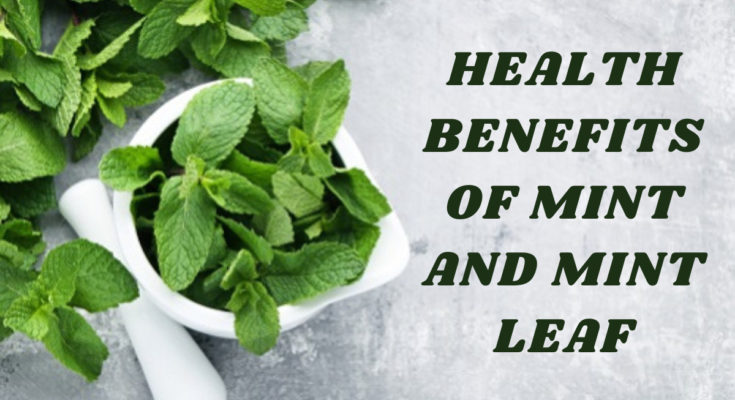MINT:-
Mint refers to a herbaceous plant belonging to the Mentha genus, which includes several species such as peppermint, spearmint, and pennyroyal. The leaves of the mint plant are commonly used in cooking and herbal teas for their refreshing and cooling flavor.
Mint leaf refers to the individual leaf of the mint plant. These leaves are usually small and oval-shaped with a pointed tip and serrated edges. Mint leaves are often used as a garnish or ingredient in dishes such as salads, soups, and sauces. They are also commonly used to flavor drinks like mojitos, mint juleps, and iced tea.
Overall, mint and mint leaves are widely used for their refreshing flavor and aroma, as well as their potential health benefits. The essential oils found in mint are known to have antimicrobial and anti-inflammatory properties, and may help relieve digestive discomfort and improve respiratory function.
HEALTH BENEFITS :-
Mint and mint leaves are known to offer a range of health benefits. Some of the potential health benefits of consuming mint or mint leaves include:
1. Relieving digestive discomfort: Mint contains compounds that may help relax the muscles in the digestive tract, which can help relieve symptoms of indigestion, bloating, and gas.
2. Improving respiratory function: The menthol in mint can help open up the airways and improve breathing. Mint leaves are often used to treat respiratory conditions like asthma and bronchitis.
3. Reducing inflammation: Mint contains anti-inflammatory compounds that may help reduce inflammation throughout the body. This may be beneficial for conditions like arthritis and inflammatory bowel disease.
4. Relieving pain: The menthol in mint has a cooling and numbing effect that can help relieve pain. This may be helpful for headaches, muscle aches, and other types of pain.
5. Promoting oral health: Mint contains antimicrobial compounds that can help reduce the growth of bacteria in the mouth. This may help prevent bad breath and reduce the risk of gum disease.
Overall, incorporating mint or mint leaves into your diet may offer several health benefits. However, it’s important to note that mint can interact with certain medications and may not be appropriate for everyone. As always, it’s best to talk to your healthcare provider before starting any new dietary or herbal supplement.
USES :-
Mint and mint leaves can be used in a variety of ways, including:
1. Cooking: Mint leaves can be added to salads, soups, stews, curries, and sauces to add flavor and freshness. Mint leaves can also be used as a garnish for desserts, cocktails, and other dishes.
2. Herbal tea: Mint leaves can be steeped in hot water to make a refreshing and soothing herbal tea. Simply add a handful of fresh mint leaves to a cup of hot water and steep for 5-10 minutes.
3. Aromatherapy: The essential oil of mint can be used in aromatherapy to promote relaxation, reduce stress, and improve mood. Add a few drops of peppermint oil to a diffuser or inhale the scent directly from the bottle.
4. Skincare: Mint leaves can be used in DIY skincare recipes to help soothe and cool the skin. Crush a handful of fresh mint leaves and mix with plain yogurt or honey for a soothing face mask.
5. Mouthwash: Mint leaves can be used to make a homemade mouthwash to freshen breath and kill bacteria in the mouth. Steep a handful of fresh mint leaves in hot water for 10-15 minutes, then strain and use as a mouthwash.
These are just a few examples of how to use mint and mint leaves. Get creative and experiment with different ways to incorporate this refreshing herb into your daily routine!
MINT NUTRITIONAL FACTS.
Mint is a popular herb used in culinary dishes, teas, and various other applications. Here are some approximate nutritional facts for 100 grams (3.5 ounces) of fresh mint leaves:
- Calories: 70 kcal
- Carbohydrates: 14.89 g
- Dietary Fiber: 8.0 g
- Sugars: 0.00 g
- Protein: 3.75 g
- Fat: 0.94 g
- Saturated Fat: 0.30 g
- Monounsaturated Fat: 0.28 g
- Polyunsaturated Fat: 0.18 g
- Omega-3 Fatty Acids: 0.12 g
- Omega-6 Fatty Acids: 0.06 g
- Vitamins:
- Vitamin A: 5698 IU (International Units)
- Vitamin C: 31.8 mg
- Vitamin E: 3.75 mg
- Vitamin K: 600.9 µg
- Folate: 88 µg
- Minerals:
- Calcium: 199 mg
- Iron: 5.08 mg
- Magnesium: 80 mg
- Phosphorus: 60 mg
- Potassium: 569 mg
- Zinc: 1.11 mg
Keep in mind that these values are approximate and can vary slightly depending on the specific variety of mint and its growing conditions. Additionally, when mint is used as a seasoning or flavoring in smaller quantities, its contribution to your overall nutrient intake is generally minimal.



